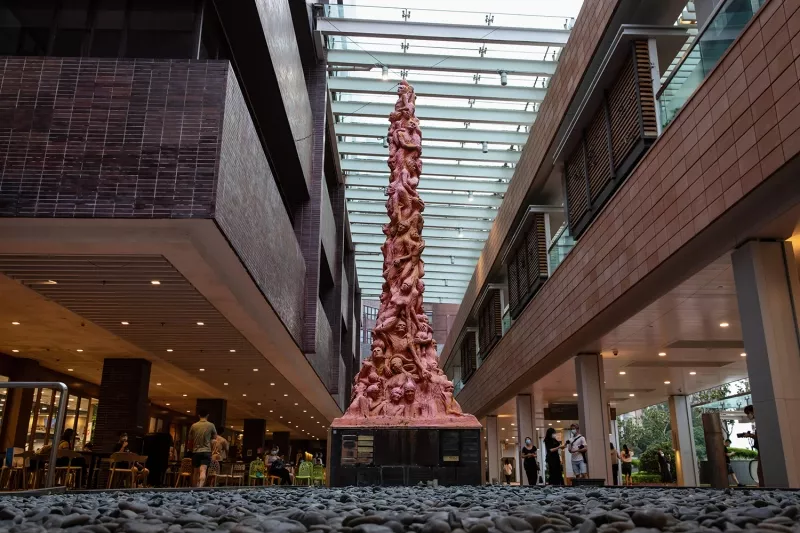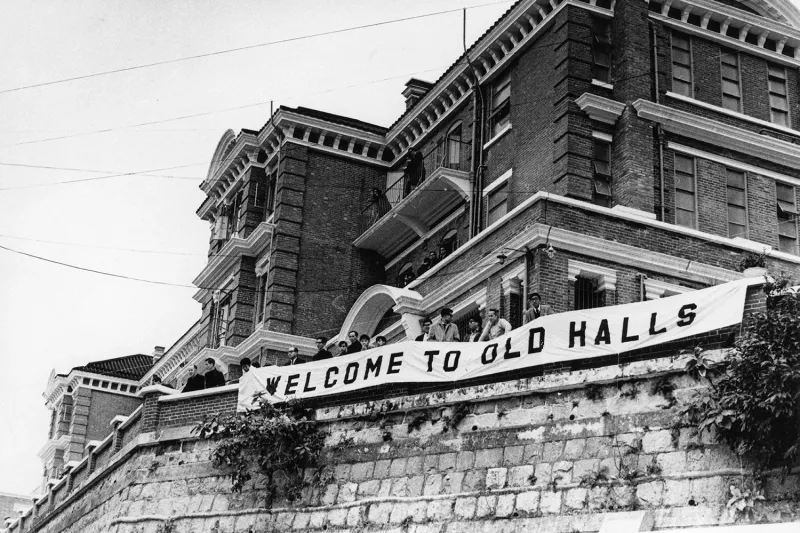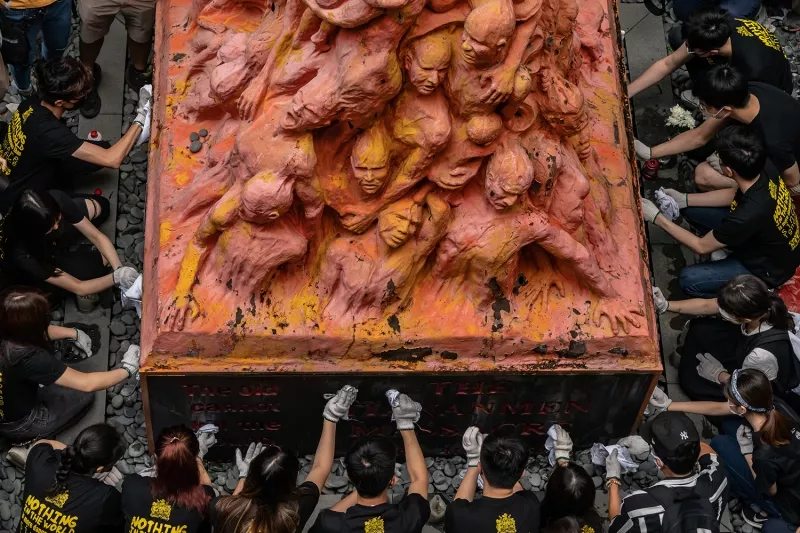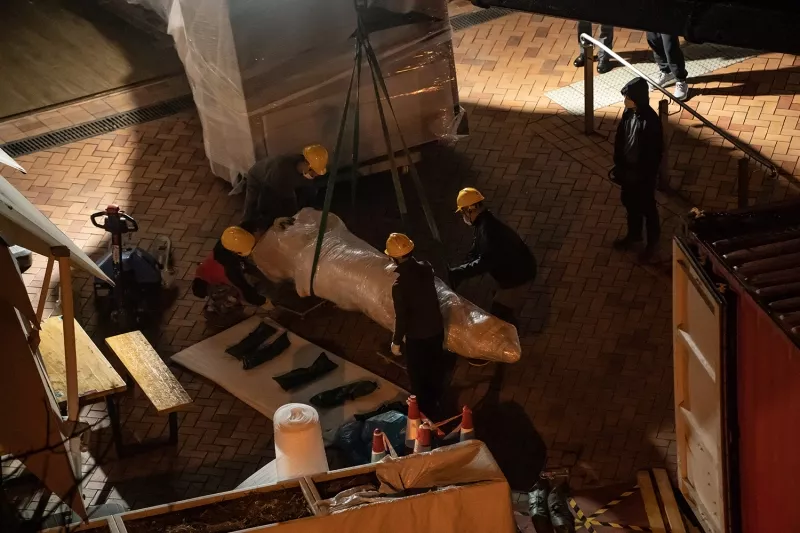
Every fall, I think about my first semester at the University of Hong Kong a decade ago. In the mornings, Iâd trek uphill toward the flame tree that guarded the entrance of the school campus, my arms aching from heavy textbooks that wouldnât fit in my backpack. After lectures, my classmates and I read poems and talked about our crushes on the benches outside the baroque-style Main Building in the chestnut light of the late afternoon sun. Winter was around the corner, but we were hopeful; our lives were just beginning.
It has been years since I graduated, but I still often found myself visiting the campus whenever I was in the neighborhood. My friend L was similarly prone to these fits of nostalgia. âDo you remember when we went out to look at the rain during our comparative literature class?â L would sometimes say at our regular meetups. I did; we had run out during a break to watch rain cut through the palm trees and melt into the fountain in the courtyard.
But at that time, the university still had a student union office and a statue commemorating a history the authorities do not want to remember, and teachers and students did not show up to class fearing their comments could be recorded by their peers and reported to the national security police. Over the past two years, Hong Kongâs National Security Law, imposed at the behest of Beijing, has seen the authorities arrest more than 180 politicians and activists, tens of thousands of people flee the city, and the rapid end of civil organizations and opposition politics. At the university, the most visible marks of the once lively environment of debate had been erased, with political posters torn down. These days, the university, much like the rest of Hong Kong, is not the same place anymore.
The University of Hong Kong, referred to as HKU or simply âKong Uâ by local university students, was established in 1911, just under a year before the end of Chinaâs last imperial dynasty. The universityâs predecessor was the Hong Kong College of Medicine for Chinese, where Sun Yat-sen, often called the founder of modern China, studied in the 1880s. The new university would go on to produce a swath of distinguished graduates: judges, pro-democracy legislators, academics, film directors, and writers. The Chinese University of Hong Kong, the cityâs second tertiary institution, would not be officially established until the 1960s.
Throughout its long history in Hong Kong, the university witnessed several important social movements. During the 1967 leftist riots against British colonial rule, the official publication of the HKU student union, the Undergrad, published an op-ed condemning violence and âmobsâ on the street while still expressing support for the labor movements.. In the 1970s, the university union held a rally over the Diaoyu/Senkaku Islands dispute, and students formed concern groups over the Yau Ma Tei boat people incident. During the Tiananmen Square protests in 1989, university unions in Hong Kong held fundraisers and organized demonstrations in support of the Beijing students.

I became a student at the university in the fall of 2011 and spent six years there for a dual degree in literature and law. For all of my first semester, I could not believe I was there. I lived a five-minute walk from the schoolâs East Gate, sharing a 300-square-foot apartment with five other students. Even in the cramped space, I was giddy with freedom. As a teenager growing up in Hong Kong with undiagnosed low-grade depression, I had often dreamed about dying. This was the first year in my life when I wanted to live, and HKU was the first place that felt like home.
My friends and I navigated the confusions of early adulthood together in this half-square-kilometer space, etching our memories into every corner of the campus. Local secondary students spend countless hours at the library preparing for the grueling public exams in order to earn one of the competitive spots at the university; now we were finally there. We wore cocktail dresses and penguin suits to the high-table dinners, swirling around our fruit juices in tall-stemmed glasses and feeling delightfully grown-up. We cheered at the lunchtime dance battles at the school plaza, cranked out papers in the learning commons until night fell upon the lily pond, and dabbled in new hobbies and vocations, buoyed by the opportunities offered by the liberating environment at the school.
When we ate at the student union canteen, the Pillar of Shame, an imposing statue of writhing bodies and faces, loomed over us. Sculpted by Danish artist Jens Galschiot, the statue was initially erected at Hong Kongâs Victoria Park in 1997, touring various local universities before being set up permanently at HKU. Every year, the Hong Kong Alliance, a pro-democracy group established in 1989 and disbanded last September after the arrest of its leaders, would visit the statue for a ceremonious âwashingâ of the statue, in tribute to the victims of the Tiananmen massacre.

Our mentors at the school showed us the existence of alternative careers and lifestyles; our teachers were champions of human rights, ran clinics to give free legal advice, and spoke out in support of labor workers during a dock strike. The stability of our identity as alumni mattered in a constantly shifting city. I wasnât always proud of Hong Kong, but I was often proud of my university.
My first two years at HKU were uneventful, but as student-led activism became mainstream in Hong Kong in the early 2010s, the atmosphere at the university also became more politically charged. University student unions and related societies have always been at the forefront of local activism, but after the Civic Square protests against so-called national education in 2012, participation became more widespread: Rather than just throwing themselves into books and sports competitions, students were eager to hold forums, propose new political frameworks in school publications, and join their peers at the front lines.
Then, in 2014, the Umbrella Movement broke out. For 79 days, protesters occupied Hong Kongâs commercial districts to demand universal suffrage. My classmates at HKU were regulars at the occupation, held on major roads only a few neighborhoods away. Lecturers gave tacit permission to skip class and attend the protests. The schoolâs student union, part of the Hong Kong Federation of Students at the time, helped organize skipping classes , and Benny Tai, an associate professor of law at the school, was one of the leaders of the initial occupation campaign.
I had been away from Hong Kong on an exchange semester during the protests and returned just after they ended. That spring of 2015, the televisions at different corners of the school broadcast student interviews about current affairs, and in a public law class, a part-time teacher reminded us of the importance of our future role in these politically turbulent times.
Walking past the student union foyer or Happy Park, Iâd sometimes find students in heated discussions with guests such as grassroots politicians or academics before a curious crowd. The pro-democracy camp was beginning to internally fracture after the movement, but students were still free to discuss the trend of localism, an ideology calling for Hong Kongâs self-determination and later, in some instances, for the city to be âliberatedââideas the government now regards as secession. When the Undergrad published a book called Hong Kong Nationalism in 2014, Hong Kongâs then-chief executive, Leung Chun-ying, in a rare move, openly criticized the students in his annual policy address. The atmosphere of the university was able to accommodate pro-protest positions or even these âradicalâ ideas.
In the aftermath of the protests, I became a reporter for a crowdfunded, newly launched news nonprofit. One of the first major events I covered took me back to the university I had left just months earlier. In early October 2015, on a weekday afternoon, I watched hundreds of students and familiar teachers solemnly march through campus in black clothes and traditional academic gowns in support of academic freedom. The poster of the event read, âThe institutional autonomy of the University of Hong Kong is under attack. ⊠We will march in voluntary silence, but we will not be silencedâ.
The protest was in response to the denial of promotion for Johannes Chan, the dean of the law school. Chan, who had welcomed my cohort on the first day of school, was criticized in pro-Beijing papers for his ties with Tai, who was in his faculty and had a prominent leadership role in the Umbrella Movement; the university claimed he was rejected from the position because he did not have a doctorate. Students and academics at the university saw this as a political decision that interfered with the supposed independence of the school and one that pointed to broader structural issues about its management.
The University of Hong Kong is publicly funded; a number of members of the universityâs governing council are appointed by the school chancellor, who is by default the chief executive of Hong Kongâa mechanism that ensures the university ultimately serves the interests of Beijing. Months after the failed appointment of the dean, hundreds of angry students surrounded the Sassoon Road campus after a governing council meeting, demanding dialogue with the new school chair. The dean never got the job, and two student union leaders who took part in the protest wound up being prosecuted for disorderly conduct and obstruction, narrowly avoiding jail time.
In the fall of 2017, campuses in Hong Kong would be swept up in a different kind of controversy: free speech within school walls. As a new semester of school began, pro-Hong Kong independence slogans began appearing on message boards and on banners stretched across plazas. The cityâs chief executive, Carrie Lam, said these banners should not be allowed and that there should be no discussion of independence. These remarks stoked alarm: Hong Kong, at the time, was not used to blatant declarations that a certain type of speech was âbannedâ. Then, that December, Zhang Xiang, who would later become the universityâs president, paid a visit to the HKU campus to take questions. A Chinese American scholar from Nanjing, Zhangâs mainland Chinese ties and lack of management experience became cause for concern. At his question-and-answer session, when asked about how he would defend academic freedom, Zhang explained that âeverything has to be said in the context of the boundariesâ.
These responses foreshadowed the type of comments the city would become used to in 2021: that people in Hong Kong still enjoyed a particular freedom, so long as it was within the law. But by design, the speech laws and national security laws are vague and broad; people cannot be certain theyâve violated the law until the moment theyâre arrested. (In 2021, speech therapists were arrested for sedition over publishing childrenâs picture books that criticized the police and were said to âstir hatredâ.) And when universities are forced to operate under this tense, fearful environment, they can no longer serve as sanctuaries for students and academics who relish in forward-thinking ideas and ideology, the breeding ground for the next generation of leaders of integrity, or safe spaces for debate.
A university, like a city or a country, has its own anthem, a set of founding principles, its own rule-makers and enforcers. As institutional independence is gradually chipped away, the University of Hong Kong becomes even more a microcosm of the city. To maintain the facade that may guarantee continual survival and the preservation of their own interests, the people and institutions in Hong Kong must keep up their nothing-to-see-here attitude while running a public relations campaign that claims everything is functioning and well.
In some ways, that isnât much different from the past. HKU has long held the goal of being the âHarvard of the Eastâ, and that elitism manifests not in standing up for independence and integrity but in touting the academic and technical achievements of faculty in a clinical, apolitical fashion. The Chinese University of Hong Kong is known for its left-leaning activism, student movements, and strong philosophy department. The HKU student stereotype during the time I was in school, in contrast, was business suits, MacBooks, and Starbucks coffee. However passionate about protest, we were still an aspiring elite, drawn to the upper-middle-class dream.
During the 2019 protests against plans to allow the extradition of criminal suspects to mainland China, HKU students attempted to barricade themselves after hearing news that the police had entered the Chinese University, and I visited the campus late one night. The slogans scrawled on the wall read: âLetâs be a revolution-university and not a school for [Hong Kong] pigsââa term that refers to people who refuse to care about politicsâas well as, âPeople are taking bullets while youâre drinking Starbucksâ.

There was a distinctly self-aware and critical flavor to the graffiti, aimed at the students who were obsessed with what they thought of as âwinningâ in a competitive cityâhomeowners, Tesla drivers, speakers at industry forums. These were the successes the school could still boast about and stake a claim over, as it left behind the faculty and alumni who fought against abuses of power, now exiled or in jail.
While the comments of university heads sometimes drew fire from students who supported the anti-extradition movement, they were still relatively aimed toward mediation. After the storming of the Legislative Council in July of that year, Zhang said he was âdisheartened by the violence that occurred in the Legislative Council building and would like to condemn such destructive actsâ. Later, he clarified that he had not intended to blame the students and reiterated in an email that the police could not enter the university, located on private premises, unless to respond to an emergency call or with a search warrant. A year later, the school would fire Tai, the Umbrella Movement leader, for âmisconductâ after a vote by the governing council.
Over the past year, as the influence of the National Security Law has seeped into every corner of life in Hong Kong, the space for the free exchange of ideas on campuses has been whittled away. The academics who have remained and are fighting to carve out space for students are now unsure about what they can teach in class. After the National Security Law was imposed, universities began toeing the party line, and heads of universities published statements in support of the law. In 2021, four HKU students were arrested for raising a motion of sympathy at a student union council meeting toward a man who died from injuries after stabbing a cop. The university soon announced that it would no longer recognize the student union, which had been around for over a century and was at the forefront of student-led activism at the school and beyond.
All the posters and publications on HKUâs Democracy Wall were taken down; student unions from other universities also began disbanding out of fear that the organizationsâ history of political activism would make them targets. There are still, within HKUâs faculty, those who remain committed to delivering quality education for their students, but these days, when alumni share news on social media about the university, it is usually to express shame at how far this century-old institution has deviated from its tradition of being a harbor for social activism. A month after banning students at the union meeting from entering campus, the university boasted on its social media, âIn the World University Rankings just released by @timeshighered, #HKU is #1 locally and has climbed nine places to #30 globally, boosted especially by our research influence!â
One evening in November 2021, after dinner in the neighborhood, L and I found ourselves making our way to the school, past the tuck shop and printers near Bonham Road, past former construction sites that have since become tall upscale residential buildings. It was fall again, but this time, we didnât want to walk through the grounds and reminisce about our golden days in a place that had become a shadow of itself. We had a different kind of mission in mind.
âDo you think there are still guards at the entrance?â L asked. After the 2019 protests, the university had installed gates and temporarily required identification before letting visitors inâa break from the long-standing tradition of opening the campus to the public.
But we made it past the East Gate without any fanfare. At 10 p.m., the poorly lit campus was strange and empty like a ghost town. Students shuffled in and out of the library like caffeinated zombies.
âLetâs go and take a look at the statue one last timeâ, she said.
A month before our visit, a law firm had sent a letter to the disbanded Hong Kong Alliance on behalf of the university, demanding the removal of the Pillar of Shame, part of an overall war on Tiananmen remembrance in Hong Kong.
At the university, the signboard next to the library, once crammed with political slogans, was blank and the student union office, vacant. L and I headed to the statue. Not far from us was a guard, eyeing us for any sudden movement.
But we did not approach the statue or take photographs of it, only regarded it in silence. I thought about the times I had run past the pillar on the way to class without pausing or looking in its direction. I had not understood then that even something as immutable and solid as a memorial could instantly become a memory itself.
Three weeks after our visit, in the dead of the night, construction workers in yellow hard hats arrived at the campus, mummified the 2-metric-ton statue in plastic wrap, and towed it out of sight. Later, in the area where the statue once stood, the university installed sleek, smooth seating structures, as if to say, on this site, nothing else had ever been here.
Karen Cheung is a freelance journalist based in Hong Kong.
